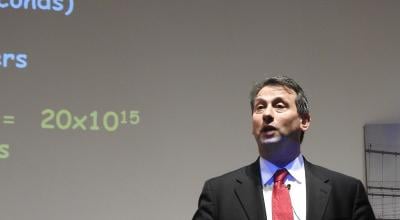This year’s spring edition of the Brooklyn 6G Summit is not back to normal.
No live demos are showing off the latest spectrum measurement instruments. Tables are not being set up to host round-table discussions about terahertz. No one will be checking badges at the door for the proper credentials.
Instead, this week’s program is an abridged, pre-recorded version lasting about two and a half hours, and it’s all online starting at 10 a.m. Eastern time on Wednesday, April 27.
The goal is to get back on the NYU campus in Brooklyn for the usual in-person event, hosted by Nokia and NYU Wireless. With luck and a healthier, less-Covid environment, it will be back live on the NYU campus for the Brooklyn 6G Summit from October 24-27, 2022.

As for this week, the theme is sustainability. “We thought that this was such an important topic to make part of 6G” because of all the batteries that are in devices and the proliferation of IoT, said Ted Rappaport, founding director of NYU Wireless who’s become a familiar face at these summits.
The pandemic directed a spotlight on the need for wireless communications, which are powering phones and other screens across the country for work, school and entertainment.
“It’s very clear that our industry is going to be a major part of the carbon footprint of the world so we really have to be sensitive and start paying attention to every watt of power consumed,” Rappaport said on the eve of the summit, hinting that NYU has developed a new theory that could become the standard mathematical tool by which device and network suppliers use to optimize for minimum power consumption.
Let’s talk about 6G
But isn’t it a bit risky to talk about 6G when 5G isn’t exactly living up to expectations?
Not according to Rappaport.
Just take a look at Verizon’s last earnings report, where CEO Hans Vestberg talked about how 5G is being adopted at a much faster rate than 4G, he said. That’s significant, and it mirrors what members of NYU Wireless’ industrial affiliate board have been saying. Covid likely has a lot to do with the rapid adoption of 5G, spurring the migration faster than previous generations.
“The adoption of 5G is really, really fast. As an academic research institution, our job is always to be pushing the knowledge and the fundamental understanding 10 or 15 years ahead of where the market is,” he said. “For an institution like NYU Wireless, it’s not too early to be talking about 6G.”
Plus, there’s a lot at stake globally. “The market is global and it’s not at all too early to be talking about 6G if we’re doing our job as a university and producing PhDs who, when they graduate in five years, will be able to develop the 6G future,” he said.
What about the mmWave critics?
NYU Wireless and other academic institutions are already looking at terahertz spectrum for the next big supply of airwaves for 6G, and they’re even higher on the spectrum than millimeter wave.
“The digitization of our world is going to require bandwidths far greater than we’ve ever considered,” Rappaport said.
However, in markets across the country, Verizon continues to take heat from mmWave critics who think Big Red made the wrong – and very costly – bet by investing too much in mmWave for 5G. It’s not a new criticism, either. The higher band spectrum for many years was not considered usable for wireless communications.
Rappaport himself presented findings to the FCC as part of its record in building a case for mmWave. The agency ended up auctioning off large swaths of the spectrum. Some say the FCC instead should have been looking for more mid-band spectrum for 5G.
Rappaport doesn’t see it that way.
According to Rappaport, mmWave plays a vital role in the 5G in stadiums – just look at the Super Bowl, for one – and stadiums and other venues in densely populated areas. Granted, he acknowledged, the advent of the C-band spectrum has perhaps put a little bit of a damper on the buildout of mmWave spectrum.
However, “it’s coming because there just is not enough bandwidth” at C-band or other mid-band ranges to carry all the kinds of applications and traffic that consumers have come to demand for massive broadband.
“It’s certainly going to come and it’s already being rolled out,” he said.The adoption of fixed wireless access (FWA) by the carriers is another trend, and part of that relies on mmWave spectrum. “It’s vital for low-cost backhaul,” he said. “Millimeter wave is huge for fixed wireless access as well as delivery to the high-density population centers – buildings, apartment buildings. There’s going to be big opportunities,” and it’s already happening, he said.
“This was always a dream I had as a wireless professor,” he said. In a paper he wrote more than 30 years ago, “I predicted that some day, most of the information would be wireless rather than wired, and fixed wireless access is where it’s really going to happen. 5G and millimeter wave is a first opportunity for us as an industry” to start cutting the cord for fiber-like fixed access to the home.
“We’re in the early days,” and if you review the quarterly reports of T-Mobile and Verizon, “it’s remarkable to see the uptick of fixed wireless,” he said. “This is the tip of the iceberg.”
